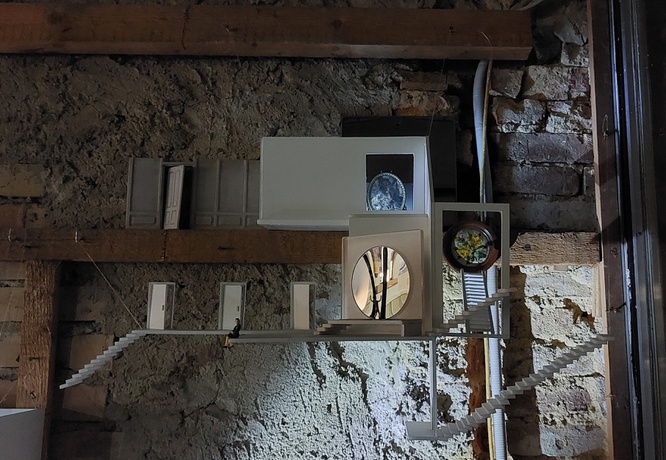Things We Don’t Understand and Definitely Are Not Going to Talk About
Site-specific Installation & Video by Dea Widya
Präsentation InstallationDie indonesische Künstlerin Dea Widya beschäftigt sich mit der Wahrnehmung wie Nutzung unserer Wohnungen und vertiefte sich in die „Idee der Innerlichkeit, um das Unheimliche in unserem Haus zu finden“. Das Unheimliche bezieht sich auf etwas Verborgenes, das aber irgendwie seltsam vertraut ist. Sie benutzt die Miniatur, das Modell, um eine neue Welt zu eröffnen, um eine Distanz aufzubauen, um eine „Flucht ins Imaginäre“ zu ermöglichen. Mit den Miniaturen stellt Widya „das Chaos des Lebens“ in winzigen, geschlossenen, statischen Räumen nach.
Im Oktober 2022 hat Dea Widya in Krems eine ortsspezifische Installation geschaffen: In der Kaltenböck-Auslage in der Kremser Fußgängerzone ermöglichen ihre Miniaturen auf etwa 4 x 1 Meter das Eintauchen in eine räumliche Erzählung, die auf die unmittelbare Umgebung Bezug nimmt.
Ergänzend schuf Dea Widya ein 5minütiges Video Essay, eine Art „experimenting parallax”, wie sie selbst sagt.
Dea Widy über ihre Installation in Krems:
Every time I see the Kaltenböck corner, I feel like watching a movie with the lights on because you try to surrender to the illusory space behind the vitrine, but at the same time the light keeps you aware of this other side of reality. The vitrine space, make everything inside it timeless. Like all the antique figurine, across the street, that leave you in eternal present with empty gazes. Inside this vitrine, I am interested in presenting situations that reveal the varied and contradictory meanings of things that occurred in private life— as the object in our house, resonate the anxiousness of our conscience, it recorded the traces of unfinished business, the future uncertainty and also the haunting past. It’s all like re-enacting all the figurine in antique store, across the street, where they supposed to belong to element of décor, which sadly is also an attempt that makes us avoidant by escaping into more illusional reality within our house.
As Adorno describe in Minima Moralia ,1999, that modern homes are a living-cases manufactured by experts for philistines, or factory sties that have strayed into the consumption sphere, devoid of all relations to the occupants. The repressed return to the individual when an empty, depersonalized container (house) is measured not to accommodate human proportions but rather to maximize profit. The only recourse is that the individual living within the lie of modern homes force to take interest in furniture design or interior decoration. Therefore, thus obsession of home decoration, merely acts as fantasy shield, protecting the home owner from unbearable reality of the impossibility of being home in the modern home. The feeling of home, provide by decoration is an attempt to defend against feeling of unhomely, comes from ultimate failures of the home in poster modern time. In this case, we see a decoration as a superficial marking that attempt to differentiate and individualize home from among its massified neighbourhoods. Content-wise, the artistic articulation of this project, choose the shop vitrine, in reference to idea of commodification, container and also consumer sphere. In contrary, the miniature of home décor, stage to create new imagination with contradictive with the consumption purpose.
As refers to Gaston Bachelard’s Poetic of Spaces, 1964, This work is a reflection of “Angst”, - a form of topoanalysis, which examine a mental experiences of our intimate spaces. Both, miniature and video, explore the unconscious architecture, within realm of interior and home décor. The chosen artistic articulation is an attempt desire to stop time. As Bachelard stated, that the way to transcend memory, past event, to produce that space which suspends time, is through imaging and hallucination. Unretrievable history is fossilized, memories stand, they do not move, and therefore for Bachelard it is space, not time, which invokes memories. Thus premises, engages us, on how we see that human action can also take place in chaotic patterns and processes which lead to spatial desperation. We see human often attempt to appropriate spaces in inept ways, such as excess of decoration as a form of unintentional emptiness. Each interior, is a sad reflection of human shortcomings.
To creative narrative within this space, I saw that the shop empty space was almost the protagonist. The objects that I choose and include comes from found object, miniatures, that cast through a metaphorical situation. For example, the disproportion between the character and other object, or overwhelming white space, implies an empty space in which unexpected experiences can occur. It ignites a dramatic situation, a metaphor for the occupants, facing impossible task, and overwhelming situation stand for the precarity occurrence within our safe space. It raises a feeling of doubt, anxiety about something that we don't understand but requires us to take action in silence, but we definitely are not going to talk about. The paradoxes interplay of our existence in our private space, simulate a notion of unhomely.
Dea Widya (geb. 1987, Blora) lebt in Bandung, Indonesien. Sie studierte Architektur und bildende Kunst. Dea Widya beschäftigt sich mit Erinnerungen und Erzählungen, die sich in Räumen ablagern sowie Geschichten, die sich einschreiben – mit der nicht greifbaren Seite der Architektur. In ihren ortsspezifischen Kunstwerken ist der Raum selbst das Medium. Derzeit erforscht sie Architektur und narrative Umgebungen durch Installationskunst, installatives Design und performative Aspekte wie Körper, Gesten und Sound. Ihre Arbeiten wurden unter anderem im Museum of Beaux Art, Brüssel, beim Europalia Art Festival, Brüssel, auf der Jakarta Biennale, bei der SouthEast Asia Triennale gezeigt. 2021 bespielte sie den indonesischen Pavillon auf der London Design Biennale und war Mentorin der Future Architecture Platform/BINA Summer Film School in Belgrad. Neben ihrer künstlerischen Tätigkeit unterrichtet sie an privaten Universitäten in Bandung, Indonesien. https://deawidya.com Instagram @dea_aw

